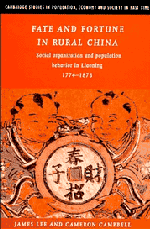Book contents
- Frontmatter
- Contents
- List of figures
- List of maps
- List of tables
- Acknowledgements
- PART 1 DAOYI VILLAGE
- PART 2 THE LIAONING DEMOGRAPHIC SYSTEM
- PART 3 HOUSEHOLD ORGANIZATION AND POPULATION BEHAVIOR
- PART 4 BANNER ORGANIZATION AND POPULATION BEHAVIOR
- EPILOGUE: PROSPECTS, IMPLICATIONS, AND COMPARISONS
- Appendices
- A Sources and methods for the population and family history of rural Liaoning
- B Statistical techniques
- C Household division contract of Lang Zhongqing and Lang Wenlin
- Glossary
- References
- Index
- Cambridge Studies in Population, Economy and Society in Past Time
C - Household division contract of Lang Zhongqing and Lang Wenlin
Published online by Cambridge University Press: 20 October 2009
- Frontmatter
- Contents
- List of figures
- List of maps
- List of tables
- Acknowledgements
- PART 1 DAOYI VILLAGE
- PART 2 THE LIAONING DEMOGRAPHIC SYSTEM
- PART 3 HOUSEHOLD ORGANIZATION AND POPULATION BEHAVIOR
- PART 4 BANNER ORGANIZATION AND POPULATION BEHAVIOR
- EPILOGUE: PROSPECTS, IMPLICATIONS, AND COMPARISONS
- Appendices
- A Sources and methods for the population and family history of rural Liaoning
- B Statistical techniques
- C Household division contract of Lang Zhongqing and Lang Wenlin
- Glossary
- References
- Index
- Cambridge Studies in Population, Economy and Society in Past Time
Summary
Because of their many family tasks they find it hard to live together. From today on all their familial possessions, with the exception of land, housing, and grain, including all furniture and household objects shall be equally divided such that each side is in agreement. If there is any disagreement, the lineage representatives and the intermediaries should adjudicate.
This document of property division is created to provide written proof of this agreement as oral agreements may prove unreliable.
• Land: Lang Zhongqing should receive 24 mu: 6.2 mu of land west of Xigang kao, 10 mu of land in Changlong kao, 3.2 mu of land in Liuyuanwen, and 4.6 mu of land in Fenlu kou.
• Housing: Lang Zhongqing should receive the eastern room and the rooms on the eastern side of the courtyard.
• Land: Lang Wenlin should receive 14.3 mu: 5.3 mu east of Xigang kao, 9 mu in Changlong.
• Housing: Lang Wenlin should receive the western room and 2 smaller rooms on the west side of the courtyard.
Lineage representatives (zuzhong ren): Lang Zhirong, Lang Zhiqiang.
Intermediaries (zhongjian ren): Guo Songyi, Ding Yizhuang, Sha Qimin.
Secretary: Zhang Caisan.
March 11, 1956 Signed Lang Zhongqing and Lang Wenlin.
Translation note: The entire text was written by one person, but the two parties, their representatives, and intermediaries each affixed their chops below their names. We have, of course, changed the names to preserve confidentiality.
- Type
- Chapter
- Information
- Fate and Fortune in Rural ChinaSocial Organization and Population Behavior in Liaoning 1774–1873, pp. 246 - 247Publisher: Cambridge University PressPrint publication year: 1997



